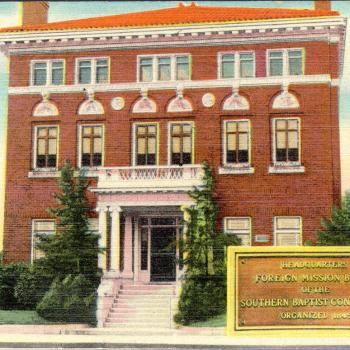From the Archive
In light of the upcoming annual meeting of the largest (for now) Protestant denominations taking place in Baltimore, MD next week, it seemed appropriate to re-run my two-part series from last summer, “A Primer on the Southern Baptist Convention.” The first part will run today, the second will run on Saturday, June 7th. Relevant updates and emendations have been made. They are indicated by italics.

Next week, the Southern Baptist Convention (SBC) will hold its annual meeting in Baltimore, MD. Over the last several decades, the SBC’s public profile has increased significantly due to the actions of its leaders and as a result of the media scrutiny that has come from solidly positioning itself on the conservative wing of American evangelicalism. Even so, very few non-Baptist journalists or readers understand the history of the SBC or grasp the organizational processes of this zealously congregational yet intensely cooperative denomination. Today, my post will briefly survey the former. Saturday (6/7), I will focus on the latter.
In 1845, the same year that Texas entered the union as a slave state, a group of Baptists in the South formed the Southern Baptist Convention (SBC). Pursuant to the cooperative spirit of the early nineteenth century, Baptists throughout America united for mission via the General Missionary Convention of the Baptist Denomination in the United States of America which met every three years beginning in 1814. Eventually, the burden of slavery would outweigh the shared theological convictions and commitment to cooperative missions that held this “Triennial Convention” together. As had already happened among the Presbyterians (1837) and Methodists (1844), the weight of slavery tipped the scales towards regional schism, foreshadowing the coming national crisis.
In the years leading up to the schism, southern Baptists desired to make slavery a non-issue, while abolitionist forces in the North (and among northern Baptists) desired the convention to take a moral stand against it. The convention felt caught in the middle. When southern Baptists from Alabama and Georgia petitioned to have slaveholders appointed as convention missionaries in 1844, the convention refused to consider them, arguing that doing so would force them to take a side in the debate over slavery. Of course, by refusing to consider the slaveholders for appointment, the Triennial Convention adopted a de facto anti-slavery stance. Predictably, Baptists in the South could not countenance this decision and began to explore their options.
The following year, a group of representatives—mostly hailing from Georgia, South Carolina, and Virginia—met in Augusta, Georgia, to consider alternatives: they ended up founding a new denomination. In its earliest years, the SBC focused its cooperative efforts exclusively on “home” and “foreign” missions. By 1859, pro-education advocates within the nascent denomination persuaded the convention to found a theological seminary—The Southern Baptist Theological Seminary—in Greenville, SC. In retrospect, the timing was particularly poor; the Civil War forced the seminary to close in 1862. Although it reopened after the war, the economic devastation visited upon South Carolina and Georgia by Sherman’s army combined with an endowment from Kentucky Baptists precipitated its move to Louisville, KY in 1877. As the denomination expanded geographically through the twentieth century, it added five other seminaries. Each adopted a confessional statement, guaranteeing a strongly denominational flavor to theological education in the SBC. The denomination also added a publication society, The Baptist Sunday School Board (BSSB), in 1892. Today it is known as Lifeway Christian Resources.
After the Civil War, the denomination struggled. Despite the shattered economy, many Baptist congregations in the South continued to send monies to denominational entities, particularly the Foreign and Home Mission Boards (now the IMB and NAMB). At the same time, like most people in the South, Southern Baptists found it difficult to accommodate themselves to the reality of an agrarian economy without slavery. Sadly, when reconstruction ended in 1877, Southern Baptists embraced Jim Crow. This overt racism persisted well into the twentieth-century. During the Civil Rights era, even though progressive elites such as seminary professors T. B. Matson (1897-1988) and J. B. Weatherspoon (1886-1964) managed to persuade the denomination to officially endorse Brown v. Board at its 1954 convention, most congregations continued to embrace segregation. Pastors who did not often paid a heavy price. However, by 1995, the convention issued its Resolution on Reconciliation, publicly denouncing its past racism, and asking forgiveness for its role in supporting slavery and segregation—an unprecedented action by a Southern denomination. Surprisingly, in the decade that followed, the SBC added more and more ethnically non-white congregations to its membership, a trend that continues to the present. Two years ago, in his home town of New Orleans, the convention elected African American Pastor Fred Luter, Jr. as president. Only time will tell whether these are outliers or the beginning of a new trend in SBC life.

- Rev. Fred J. Luter, Jr.
While the SBC and several of its entities nearly folded during the depression years, the denomination experienced its greatest growth after World War II as evangelistic efforts, the postwar religious revival, and the baby boom swelled the membership rolls of most congregations. In 1944, it had vacated all comity agreements with the Northern Baptist Convention. By 1964, there was at least one Southern Baptist congregation in every state, and in the late twentieth-century, it emerged as the largest Protestant denomination in the United States. Intensely evangelistic, it also became the largest mission-sending denomination. Along the way, the denomination conducted a very public fight over the theological direction of the convention. Although more rhetorical names for this protracted struggle are often used, especially by the protagonists on each side, “The Controversy” remains the most neutral descriptor.
During The Controversy, a broad coalition of theological conservatives struggled to gain control of the denominational apparatus. Beginning at the 1979 Houston convention, they elected a series of theologically-conservative presidents that, in turn, used their appointive powers to achieve a conservative majority on the Board of Trustees of each of its entities—including the six seminaries, the two mission boards, and the BSSB. By 1994, conservatives had achieved their goals. As a capstone to this effort, the convention revised its confessional statement in 2000. Furthermore, each entity adopted the revised Baptist Faith & Message as its doctrinal standard. Although most congregations decided to remain in the SBC, the success of the conservatives spawned at least two spinoff organizations: the moderately progressive Cooperative Baptist Fellowship (CBF) and the liberal Alliance of Baptists. Over that last decade, both have moved from being protest groups within the SBC to becoming denominations in their own right.
For the time being, the SBC remains the largest Protestant denomination in the United States. For how much longer that will remain true is anyone’s guess. As the Baby Boomers who were the foundation of the SBC’s phenomenal growth in the post-war period are beginning to pass off the scene, millennials are leaving the SBC to become “nones” or join non (for now) denominational churches. Further, the convention-wide fervor for evangelism that characterized the denomination in its halcyon days appears to have cooled and the number of new baptisms is not sufficient to replenish its ranks. (Yesterday, Tommy Kidd posted, “What Can Stop the Southern Decline?,” which addresses many of these issues and provides links to several other articles that do the same.) Only time will tell if the SBC’s best numerical days are behind it, whether the future will bring a reversal in its numerical decline, whether it will recover an evangelistic fervor, or whether it will adjust in order to content itself with a smaller number of faithful adherents. One thing is for certain, the decisions made in Baltimore next week will have an important impact on that future.
true is anyone’s guess. As the Baby Boomers who were the foundation of the SBC’s phenomenal growth in the post-war period are beginning to pass off the scene, millennials are leaving the SBC to become “nones” or join non (for now) denominational churches. Further, the convention-wide fervor for evangelism that characterized the denomination in its halcyon days appears to have cooled and the number of new baptisms is not sufficient to replenish its ranks. (Yesterday, Tommy Kidd posted, “What Can Stop the Southern Decline?,” which addresses many of these issues and provides links to several other articles that do the same.) Only time will tell if the SBC’s best numerical days are behind it, whether the future will bring a reversal in its numerical decline, whether it will recover an evangelistic fervor, or whether it will adjust in order to content itself with a smaller number of faithful adherents. One thing is for certain, the decisions made in Baltimore next week will have an important impact on that future.













